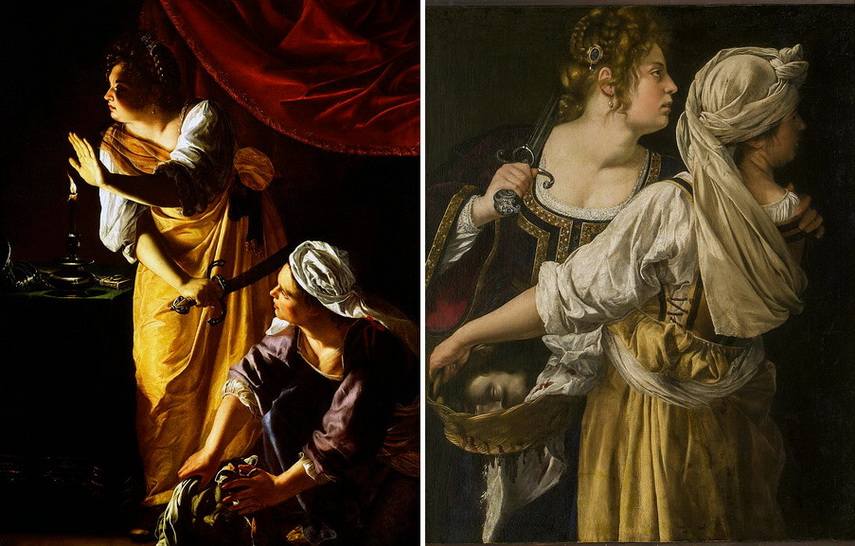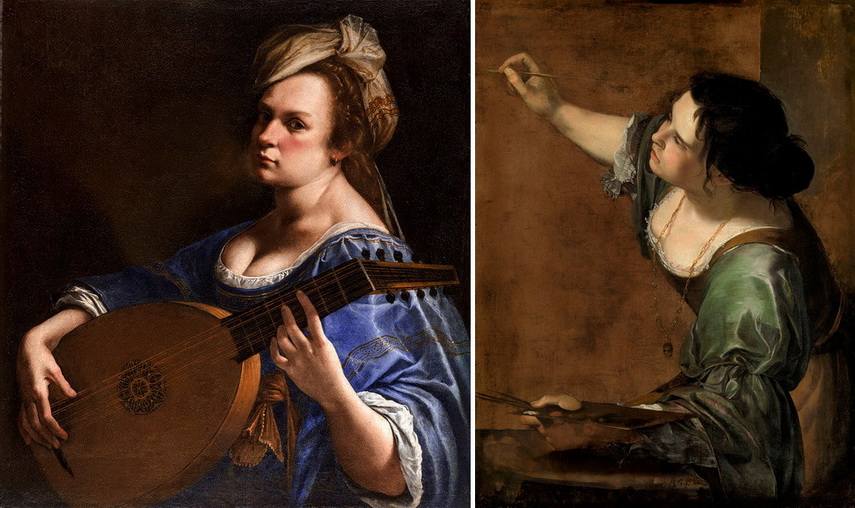Judith Slaying Holofernes by Artemisia Gentileschi, A Feminist Masterpiece
Among the pioneering female artists from the Baroque period there was the celebrated Italian Artemisia Gentileschi. Although she came from the established artistic family, her father being famous Tuscan painter Orazio Gentileschi, and was exposed to the traditional set of themes (historical/religious), she managed to form specific and recognizable painterly approach based on a feminist agenda.
Throughout her career, Artemisia Gentileschi was focused on painting tormented, yet strong women associated with allegories, myths, and Biblical narratives. She showed an astounding skill for depicting female features (whether nudes or fully clothed figures), handling color, and building depth.
One of her works that received the most attention, especially in the contemporary moment, is Artemisia Gentileschi's Judith Slaying Holofernes painted in 1610. This particular theme was often interpreted by the artists of this period indicating it was a standard one, however, the way this painter presented it made it iconic in the broader context of the feminist question. Aside from the incredible craftsmanship, this masterpiece reflects an immense symbolic quality and is perceived as a pioneering visual commentary on institutionalized misogyny and demand for women's rights.

The Mythic Scene Interpreted By Artemisia Gentileschi
Artemisia Gentileschi's Judith Slaying Holofernes painting depicts the moment when Judith, helped by her maid, beheads the drunken general Holofernes after he falls asleep. The dramatic scene is based on the Biblical story from the apocryphal Book of Judith in the Old Testament, which narrates the assassination of the Assyrian general Holofernes by the Israelite heroine Judith. Almost ten years later, Artemisia Gentileschi painted the second version of this scene that is now held in the Uffizi gallery in Florence. The patron of the painting is unknown, and it was first documented in the Signora Saveria de Simone collection in Naples in 1827.
Gentileschi used a darker color palette indicating intense chiaroscuro; while Judith wears a cobalt blue dress with gold details, the maid wears a red gown, and both females have their sleeves rolled up. The light shines directly on the scene from the left.
Now, to understand better why Judith is presented as a ruthless assassin, it is important to note that during the time painting was made Gentileschi was seventeen years old and she suffered greatly for being exposed to a tiring trial after being raped by her father’s collaborator the artist Agostino Tassi.
Namely, the young painter was taught by her father and around that time she was just starting to develop as an artist. In painterly terms, this work reflects the dominating influence of Caravaggio, while in psychological terms it shows the young painter’s inner struggle with trauma. The other paintings which also manifest Gentileschi’s discontent with her own status and the status of women in general at the time are Susanna and the Elders and Madonna and Child. It is remarkable how she managed to transmit the message concerning the patriarchy and repression through painstaking body movements and facial expressions.
Transfixed by the defeating impression regarding the position of women, Gentileschi started interpreting similar subjects, few of them again featuring Judith. For instance, Judith and her Maidservant (1613–14) depicts Judith holding a dagger and her maid holding a basket with a severed head inside, while others depict a maid covering the head of Holofernes, while Judith herself looks out the frame of the picture.

Interpretations of The Masterpiece
Judith Slaying Holofernes was usually interpreted by the scholars as related to the Power of Woman theme. According to historian Susan L. Smith, it is "a representational practice of bringing together at least two, but usually more, well-known figures from the Bible, ancient history or romance to exemplify a cluster of interrelated themes that include the wiles of woman, the power of love and the trials of marriage."
Gentileschi portrays Judith as a beautiful, yet vile woman indicating her domination over a man. The painter seems to had played around with stereotypes while celebrating her character as a genuine heroine. The atmosphere of a heroic act was achieved with the apparent solidarity between the two females and the splashes of blood all around which symbolize the conquered battle/public space.
Various art historians analyzed the painting, however, many interpretations not only of the painting but of Artemisia Gentileschi’s entire oeuvre emerged in the light of Linda Nochlin’s iconic feminist essay Why Have There Been No Great Women Artists from 1971.
The art historian Mary Garrard, who wrote the first Artemisia Gentileschi biography, suggested that Judith Slaying Holofernes represents Judith as a socially liberated woman who punishes masculine deeds, in this case, the wars. Furthermore, Garrard suggested an autobiographical interpretation of the painting, underlining that it functions as a cathartic expression of the artist's private, and perhaps repressed, rage. On the other hand, distinct feminist art historian Griselda Pollock proposed that "the painting should be read less in terms of its overt references to Artemisia’s experience than as an encoding of the artist's sublimated responses to events in her life and the historical context in which she worked."
There was also a negative suggestion, expressed by American professor Camille Paglia, that modern feminist fascination with Artemisia is misleading since her accomplishments are exaggerated by stating: "Artemisia Gentileschi was simply a polished, competent painter in a Baroque style created by men."

The Significance of The Artemisia Gentileschi Judith Slaying Holofernes
Artemisia Gentileschi was the first woman to get accepted into the Accademia delle Arti del Disegno (Academy of the Arts of Drawing); she was considered a respected artist of her time along with her male peers. Her career successfully continued after the initial phase, and in 1638 together with her father Artemisia moved to England to work as a court painter at the court of Charles I of England (whose collection includes one of Artemisia’s paintings - the Self-Portrait as the Allegory of Painting). As the painter grew older, her work became more graceful which has to be the result of her conscious articulation of a woman painter.
Finally, it is evident why Artemisia Gentileschi's Judith Slaying Holofernes is such an iconic painting and a symbol of women's emancipation. It may be regarded as well the same in the contemporary moment in the context of the MeToo movement and the growing debate concerning gender equality.
Editors’ Tip: Artemisia Gentileschi: The Language of Painting
Hailed as one of the most influential and expressive painters of the seventeenth century, Artemisia Gentileschi (1593–ca. 1656) has figured prominently in the art historical discourse of the past two decades. This attention to Artemisia, after many years of scholarly neglect, is partially due to interest in the dramatic details of her early life, including the widely publicized rape trial of her painting tutor, Agostino Tassi, and her admission to Florence’s esteemed Accademia del Disegno. While the artist’s early paintings have been extensively discussed, her later work has been largely dismissed.
Featured image: Artemisia Gentileschi - Judith Slaying Holofernes, between 1614 and 1620. Oil on canvas, 158.8 x 125.5 cm (62.5 x 49.4 in). Collection Uffizi Gallery, Florence. Captions, via Creative Commons.
Can We Help?
Have a question or a technical issue? Want to learn more about our services to art dealers? Let us know and you'll hear from us within the next 24 hours.

